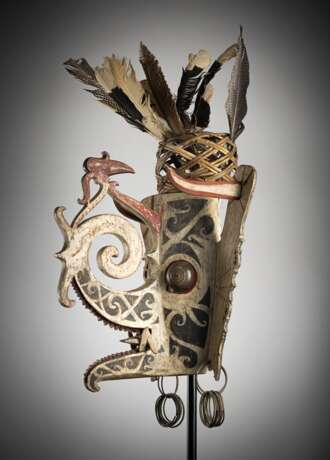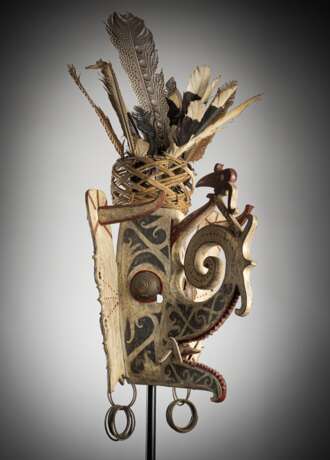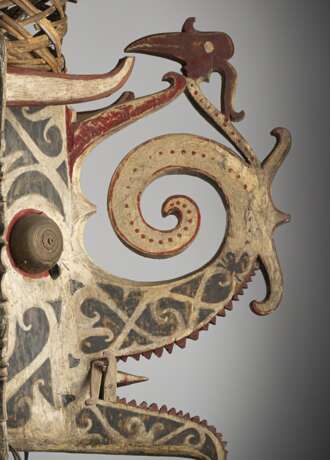ID 1217998
Lot 1481 | Tanzmaske ''hudoq“ aus Holz
Estimate value
€ 900 – 1 500
H. 36 / 48 cm
Masken dieser Art, hudo oder hudoq genannt, sind typisch für die traditionellen Dayak-Kulturen Borneos. Sie finden Verwendung bei den gawaii (Festivals) der Dayak, die als landwirtschaftliches Festival jedes Jahr im September und Oktober stattfindet. Diese hochwertige hudoq-Maske repräsentiert einen Drachen-Nashornvogel-Geist. Sie ist aus Holz von geringer Dichte gefertigt, die Ohren sind mit Holzdübeln eingesteckt. In den Ohrlöchern sind Ohrgehänge aus Messingringen befestigt. Auf dem Kopf trägt sie einen geflochtenen Korb, in den Federn des Nashornvogels, Argus-Fasans und Pfaus eingesteckt sind, was dem Federschmuck des traditionellen Kriegers und Kopfjägers entspricht. Die Fassung ist mit weißen, roten und schwarzen Pigmenten ausgeführt. Die Augen sind aus gravierten Messingschalen gefertigt. Wie auch bei den Spiegelglas-Augen, die sich bei anderen hodoq-Masken finden, dient das ursprünglich hochpolierte und somit spiegelnde Messing dazu, die bösen Geister abzuwehren, die sich beim Anblick ihres eigenen Antlitzes abwenden. Nach traditionellem Glauben verkörpern hudoq („Gesichter“) vor allem dreizehn namentlich bekannte Schädlinge, die die Ernte zerstören, darunter Ratten, Löwen und Krähen, für die es jeweils Masken gibt. Die maskierten Tänzer betreten die Dörfer als personifizierte Geister, um die Ernte durch den magischen Tanz zu schützen. Während des Festes treten zunächst Masken auf, die die "Schädlinge" darstellen. Der Tanz findet seinen Höhepunkt mit zwei auftretenden aso- (Drachen-) und Nashornvogel-hudoq, den Schutzgeistern der Dörfer, die als Krieger die Schädlinge jagen. Schweinemasken z.B. symbolisieren die „negativen“ Tiere, welche die Ernte fressen oder zerstören können. Der Maskentanz zieht während des Festivals von Dorf zu Dorf. Während des Festes rufen die manang, Schamanen, die Götter von Apulagan, der Anderswelt, an, um eine reiche Ernte und Glück zu sichern. Holz, Rattan, Pigmente, Federn, Weichmetall
Aus einer alten deutschen Privatsammlung, seit den 1950er Jahren gesammelt - Minim. Altersspuren, partiell kleine Best.
Lit.: Ave, J.B. / King, V. (1986): People of the Weeping Forest. Tradition and Change in Borneo. Leiden. - Hein, A.R. (1895): Zur Entwicklungsgeschichte des Ornamentes bei den Dayaks. Wien. - Heppell, M. (2005): Iban Art. Sexual Selection and Severed Heads. Amsterdam. - Hoskins, J. (1996): Headhunting and the Social Imagination in Southeast Asia. Stanford University Press.
| Auction house category: | Ethnographic tribal art |
|---|
| Auction house category: | Ethnographic tribal art |
|---|
| Address of auction |
Nagel Auktionen GmbH Neckarstrasse 189 - 191 70190 Stuttgart Germany | ||||||||||||||
|---|---|---|---|---|---|---|---|---|---|---|---|---|---|---|---|
| Preview | |||||||||||||||
| Phone | +49 (0)711 649 690 | ||||||||||||||
| Fax | +49 (0)711 649 69696 | ||||||||||||||
| Buyer Premium | 29,5% | ||||||||||||||
| Conditions of purchase | Conditions of purchase | ||||||||||||||
| Business hours | Business hours
|





